Insight An inside story of the 1940’s Patek ref 1415 world-time in platinum
Fine WatchesCollector's InsightSometimes it takes a groundbreaking event, like the return of a great wristwatch, to confirm something you always suspected.
When Christies Asia announced the Patek ref 1415 world time is returning to the market, I made a few phone calls. I quickly found out one man played a key role in the history of that watch. That man is Davide Parmegiani, super dealer and now auctioneer co-owner, who is known to have handled some of the greatest wristwatches in the world. Sometimes they passed through his hands not once, but twice. As was with the steel 1518 (which Hodinkee covered in a great video). And now it seems also with this 1415 Worldtime complication.
Here is an inside story of the watch, its history of some of its owners, the details about the dial and what it might fetch in May, when it comes for sale in Hong Kong May 22nd by Christies.
The story of the Patek 1415 world time goes back far before it made headlines news in the watch world back in 2002, when it sold at Antiquorum under Patrizzi for CHF 6.6m. It was the most expensive wristwatch sold in the world at that time.
We need to go back to the 1980s to fully explain what happened (even if the watch probably had a fascinating history before then). The story really starts in New York in February 1988 when the watch is listed at Sotheby’s for sale. You can see the Patek 1415 together with some other watches on the front catalogue of Sotheby’s below. The fact that it shares the cover with other watches suggests that the market (or professionals other than Davide) did not realise the importance of the watch back then, even if we see a ref 1436 split second chronograph from Patek in yellow gold sharing the cover too. Oh and in case your wondering. Davide also had his hands in two other lots on the cover below.
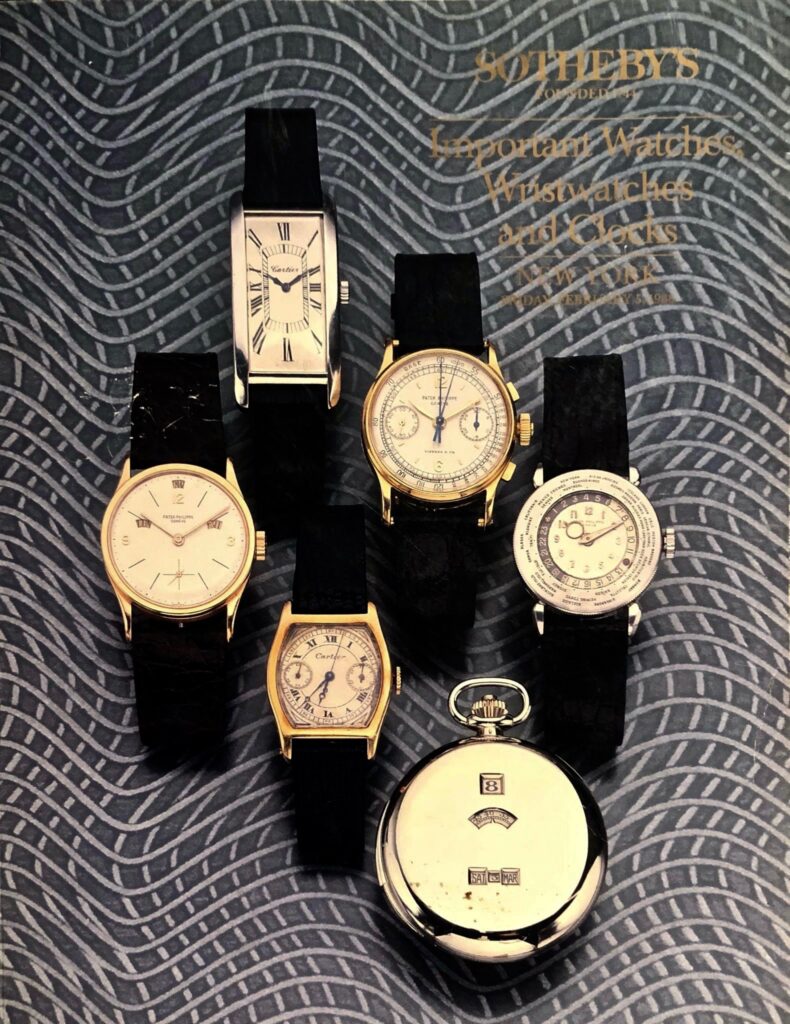
(Sotheby’s auction catalogue cover 1988 May in NY. Patek ref 1415 platinum world time is far right). Credit: Goldberger.
Under the advice of Davide (who indirectly handles the sale via an agent), an Italian collector buys the watch from Sotheby’s. The price is approximately $175’000. The name of the Italian collector is: Giorgio Seragnoli.
Some collectors might have heard of him, he is the author of the well-known Cartier book White Cartier or ‘Cartier Blanco’ together with Oswaldo Patrizzi. But before collecting Cartier, Giorgio was collecting only white metal Patek. And this is where Davide comes in. As mentioned Davide indirectly handles the sale to Giorgio via his agent in Bologna. At the time Giorgio is said to have been the biggest collector of white metal Patek Philippe in the world. His taste however starts to change and he moves on to Cartier becoming one of the most important collectors of Cartier globally. He collected only Platinum and white gold Cartier and displays most of his collection in the book White Cartier.
Having moved on to Cartier, Giorgio sold the 1415 Patek via a trade to an Italian lady, a customer of Davide. A few years later, sometime in the late 1990’s the lady had sold back the watch to Davide who kept it a few years. Davide now becomes the indirect owner for the second time. Fast forward to 2002, and Davide decides to put up the watch for auction. Why? At the time, Oswaldo Patrizzi, who was the powerful owner and auctioneer at Antiquorum back then, had an Asian client in mind, and asked Davide to put the watch up for auction. It was there at Antiquorum where the watch would make auction history. It became the most expensive wristwatch ever to sell at auction. Selling for over CHF 6.6m back in 2002.
According to Davide, it was the absolute highlight of his career so far. That is saying something because some great watches had passed through his hands before then (like a few 1518 in steel, several 2499 pink first series, a black dial 2499 and black dial 2438). But achieving a world-record for a wristwatch at auction is obviously not something that happens every day. And the buyer? According to many serious sources with knowledge of the matter, the buyer of the watch is believed to be an Asian tycoon, the head and owner of one of the largest conglomerates in the world, Samsung Group. The buyer was ‘Chairman Lee‘ as he was globally known.
This essentially is the short history of the Patek 1415 from the 1980’s until now.
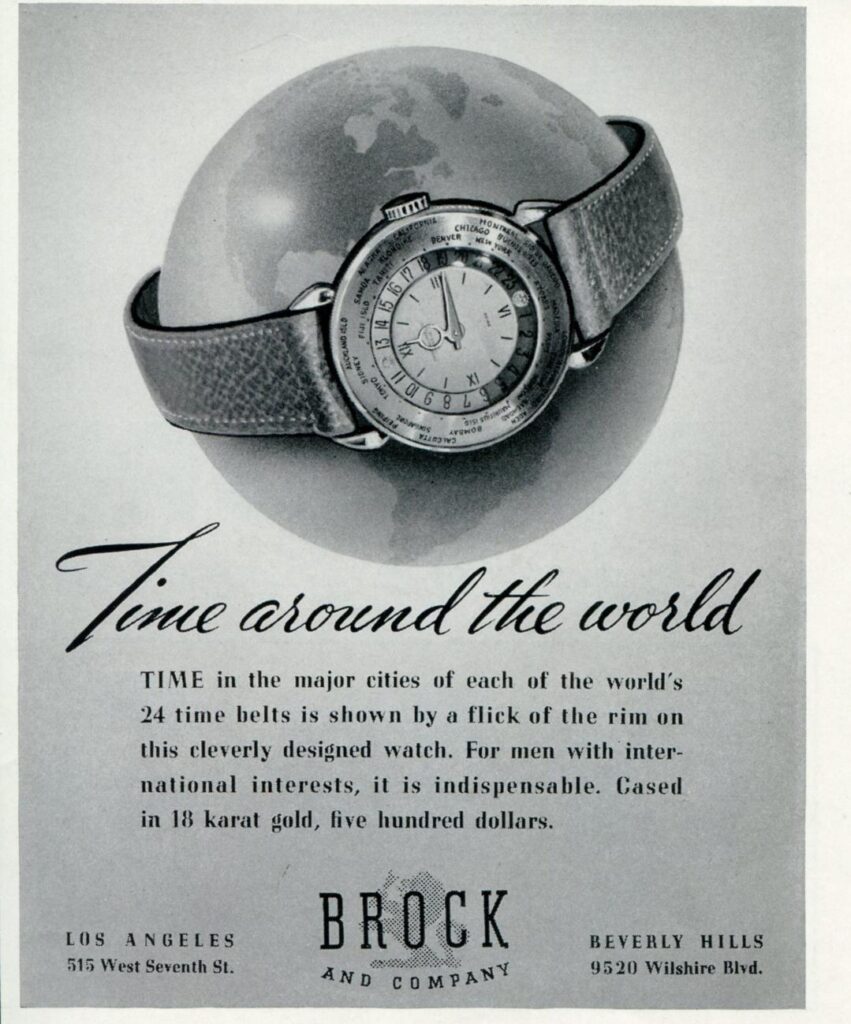
(An early advertisement for the 1415 Patek world time for the global traveler – cost is $500. Credit: John Reardon / Collectability).
Now you might wonder why would this particular watch, which is certainly not the most important Patek ever made, sell for that high? It is good question to ask and I am not sure I have the answer. This is what I can tell you though.
First, the buyer was a global billionaire who had revolutionised the global electronics industry. Second, the watch reflected a different time in watch collecting. Let me expand on both points.
At the time, the buyer of the watch is believed to be Chairman Lee, extremely wealthy (he was worth billions) turning Samsung, a small company he inherited from his father, into global powerhouse in technology and creating in the process maybe the strongest brand name in Asia. He got there by being a workaholic who famously once told employees to ‘change everything but your wife and kids’ in order to succeed. In another legendary move he ordered 150’000 Samsung phones destroyed in front of 2000 executives as he didn’t approve of the quality. This was a man who had an iron determination to succeed and why he remains one of the icons of global business.
While he worked hard and was ruthless in business, he had a big passion for collecting. He wanted the best in everything. Cars (he owned a 330 LMB Ferrari (value +$20m) among many others, watches (apparently a collection of a few hundred), and Art. Alone his art collection is so vast and valuable ) that it is said his collection alone with make it a top 5 global art museum in terms of value and quality in the world! Chairmen Lee was a serious and compulsive collector. He had the money and knowledge to buy the very best of anything he wanted. This certainly plays a role of why the 1415 Patek went so high. This was a buyer with very very deep pockets (at the time of his death last year – his fortune was estimated at $17bn). And it only takes a good story, a great watch and two bidders to drive up the price of something.

(Chairman Lee as he was known was the most powerful man in S Korea and one of Asias best known businessmen). Credit: South Korea Herald.
Secondly, I think the price was high because of the times back then. What do I mean?
Back in 2002 this type of watch, a small 31mm Patek, unique and important in history (it is after all among the very first world time made) was more highly valued by collectors than today. It was a watch for collectors who valued the art of watchmaking and design and obviously – it was a unique piece. The size of the watch didn’t matter so much as it does today. Aurel Bacs, the head auctioneer and senior consultant of Phillips watches – the world leading auction house for special timepieces-made a very good point. He said ‘back then in 2000 you had collectors who had the deep pockets but also the knowledge to buy pieces like the 1415. Today you don’t necessarily have this. Because of the new generation of collectors (and the older generation leaving) you have people with perhaps even deeper pockets but maybe not the knowledge or refinement’. As far as his prediction of the outcome of the 1415 at auction, he said it is ‘completely unpredictable. Anything could happen. It is simply unknown’.
What is maybe true (and it is just my gut feeling), at the time this gentleman might have overpaid. According to a leading expert I talked to, the expected normal price for this watch was around CHF 1.5-2m at the time. Granted, this is a tricky exercise to do, because what is normal, for a unique piece? What in my view is very telling, is the price that Christies has set as the estimate for May HK 2021 when the watch will be sold. It is USD 2.5 -4.6m. That is quite a drop from what it achieved almost 20 years ago. In fact the 1415 Patek is not even the top lot of the auction, that belongs to the fantastic 3448 Patek Banberry (estimate is USD 3.1m – 5m). I think Christies has done a great job with placing a realistic estimate on the 1415. But it only takes two bidders who want something strong enough, to drive up the price to 2002 levels.
Instead of speculating what the watch might bring, let us address a more important question. What is the condition of the watch and what attributes make this watch so special?
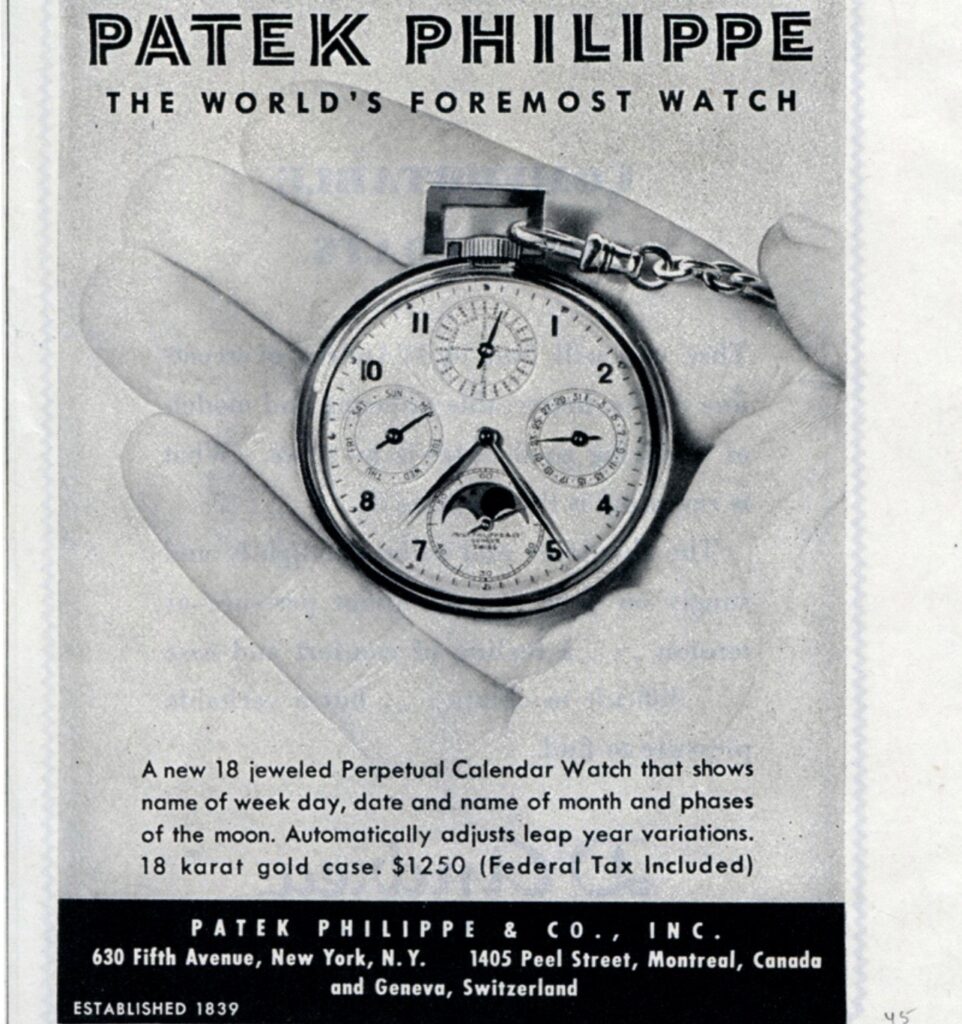
(A Patek advertisement displaying Pateks strength in complications – perpetual calendar. Owning a Patek was always meant to be something special and extra-ordinary. Credit: Unknown).
This is what we know right now in terms of condition of the watch and the dial peculiarities.
According to Davide, the Patek ref 1415 platinum world time was born with this dial and the special white gold numerals on it. Davide recalls a conversation he had, with then the director of the Patek Museum, Arnaud Tellier about it who confirmed at the time the special dial. The Patek 1415 platinum is indeed a unique piece and has a special dial with Arabic numerals in white gold. The hands of the watch are also made in white gold. As the catalogue lot notes from Antiquorum in 2002 clearly states:
Three-body, solid, polished and brushed, hand-engraved revolving reeded bezel bearing the names of 41 cities in the world, teardrop faceted lugs. Matte silver with applied white gold Arabic numerals, concentric, revolving dial in 24 hours for the nocturnal and diurnal hours. White gold fancy hands. M. Cal. 12”’-400 HU. Dial, case and movement signed. Diam. 31 mm.
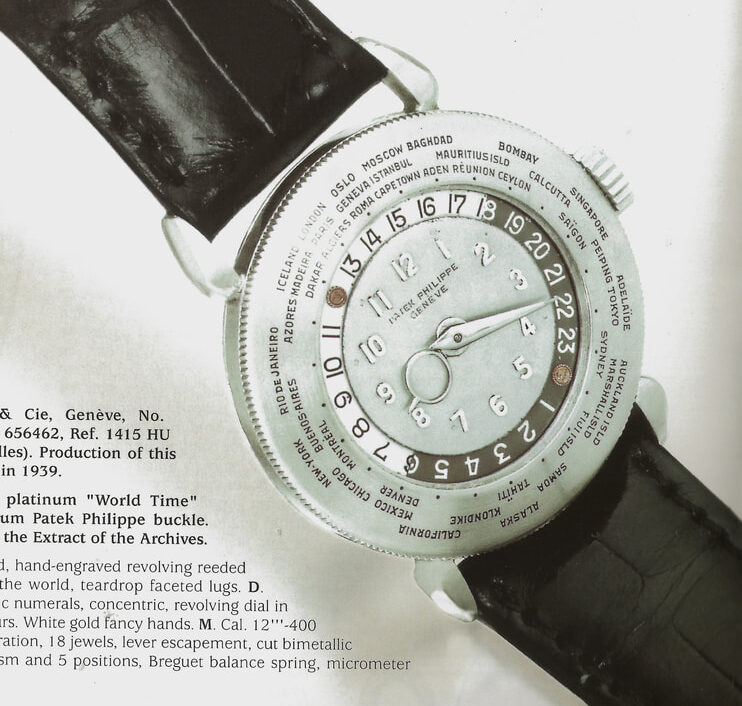
(Credit: Antiquorum).
In terms of condition, we will have to wait to see what Christies tells us end of April. Davide could not tell me much as far as condition is concerned as he has not seen the watch since 2002 when it last got sold.
So, what makes this world-time watch special besides being probably unique in that its cased in platinum? Well it is extremely important in Patek’s history.
Remember it is the first reference world time that Patek Philippe would sell on the market successfully (leaving aside the prototypes before it) and thus can be considered the first production world time Patek. Secondly, the complication is something that is still extremely useful today. The ingenious system created and developed by Louis Cottier would create an entire brand for the sophisticated traveler who could tell time in multiple time zones and the Patek 1415 was the start of all that.
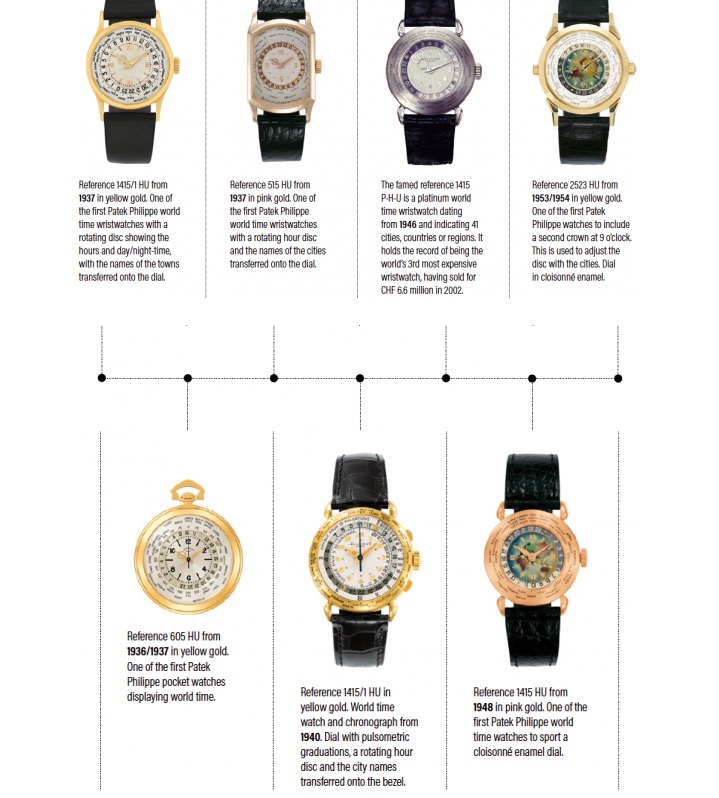
(Different world time made by Patek /Credit: Patek Magazine & Europastar. Platinum 1415 is at the top second from right).
Today the world-time watch is an essential part of Patek’s history and a large part of Patek DNA. Global travel has only increased steadily since the 1940s and there was always a connoisseur or global traveler who wanted to tell time in many different time zones. So in terms of the history of watch making and since it does represent the very beginning of watches with the world-time function – the Platinum ref 1415 gets very high marks. This was the case even 20 years ago.
When this watch sold in 2002 it was followed and appreciated by collectors for its importance in not only the complication, but also the design and history. This presumably also explains why it fetched such a high price at auction back in 2002. Collectors appreciated the sophistication of a 1415 that it was the very beginning of the wold-time era for Patek.
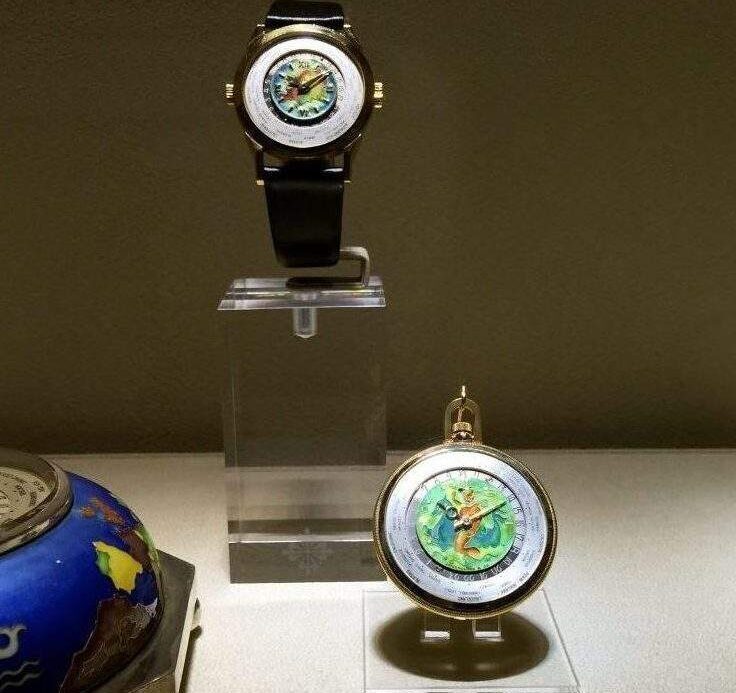
(Various Patek world time watches seen when I went to the ‘Patek Watch Art Grand Exhibition’ in London 2015. Left to right: A Enamel desk watch, a 2523 double crown World time with cloisonné map of Eurasia and right a 605 HU with cloisonné Enamel figure).
Closing thoughts
I think the 1415 Patek is a great watch, full of history. It’s importance is clear.
The fact that it is such a landmark watch for Patek and is now available again after 20 years is very positive for the entire vintage watch market in my view, and I sincerely congratulate Christies watches. It will be very good test how the market treats and values such a historic piece. Will size matter (after all it is a 31mm watch) or will the collectors be ready to bid aggressively and fight over this trophy watch that ranks very highly in terms of historical importance but maybe less so in terms of wearability?
I asked Davide what his thoughts were and he said something interesting. He said it only takes two important players that collect Patek in Asia or globally (and there are many many more) to be interested in this watch and the price could escalate far above the official Christies estimate of $2.5 -4.6m.
I think there is even a bigger picture thought involved here. This 1415 Patek represents only one watch in a vast collection of over 500 watches (that is my guess as nothing is confirmed by Chrisites) that will come to the market in the next 12 months by this one large Asian collector. It is the first time in my memory that such a vast collection has come to the market. I am curious how the market will absorb it. In my mind vintage collectors are more ready then ever, with more capital than ever to buy trophy watches*.
Let us see how all this plays out.
*Speaking of trophy watches while writing this post, Phillipswatches has just announced that they have a 1950’s Patek 2523 world time (size 36mm) at their Geneva auction; so it will be super interesting to see how this watch (which is one of 11 cloisonné Enamel maps 2523) fares against the 14 15 world time (unique piece). How will collectors prize both trophy assets? Time will tell.
** I did not consult Christies or Antiquorum for this story and as I result I take full responsibility of the story if the facts are not correct
